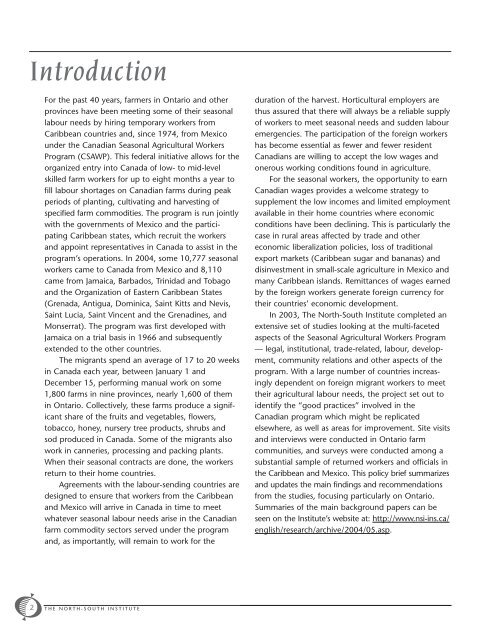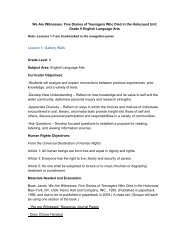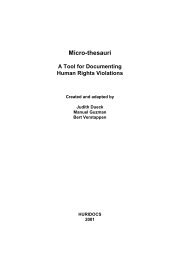Migrant Workers Canada
Migrant Workers in Canada - The North-South Institute
Migrant Workers in Canada - The North-South Institute
- No tags were found...
You also want an ePaper? Increase the reach of your titles
YUMPU automatically turns print PDFs into web optimized ePapers that Google loves.
Introduction<br />
For the past 40 years, farmers in Ontario and other<br />
provinces have been meeting some of their seasonal<br />
labour needs by hiring temporary workers from<br />
Caribbean countries and, since 1974, from Mexico<br />
under the Canadian Seasonal Agricultural <strong>Workers</strong><br />
Program (CSAWP). This federal initiative allows for the<br />
organized entry into <strong>Canada</strong> of low- to mid-level<br />
skilled farm workers for up to eight months a year to<br />
fill labour shortages on Canadian farms during peak<br />
periods of planting, cultivating and harvesting of<br />
specified farm commodities. The program is run jointly<br />
with the governments of Mexico and the participating<br />
Caribbean states, which recruit the workers<br />
and appoint representatives in <strong>Canada</strong> to assist in the<br />
program’s operations. In 2004, some 10,777 seasonal<br />
workers came to <strong>Canada</strong> from Mexico and 8,110<br />
came from Jamaica, Barbados, Trinidad and Tobago<br />
and the Organization of Eastern Caribbean States<br />
(Grenada, Antigua, Dominica, Saint Kitts and Nevis,<br />
Saint Lucia, Saint Vincent and the Grenadines, and<br />
Monserrat). The program was first developed with<br />
Jamaica on a trial basis in 1966 and subsequently<br />
extended to the other countries.<br />
The migrants spend an average of 17 to 20 weeks<br />
in <strong>Canada</strong> each year, between January 1 and<br />
December 15, performing manual work on some<br />
1,800 farms in nine provinces, nearly 1,600 of them<br />
in Ontario. Collectively, these farms produce a significant<br />
share of the fruits and vegetables, flowers,<br />
tobacco, honey, nursery tree products, shrubs and<br />
sod produced in <strong>Canada</strong>. Some of the migrants also<br />
work in canneries, processing and packing plants.<br />
When their seasonal contracts are done, the workers<br />
return to their home countries.<br />
Agreements with the labour-sending countries are<br />
designed to ensure that workers from the Caribbean<br />
and Mexico will arrive in <strong>Canada</strong> in time to meet<br />
whatever seasonal labour needs arise in the Canadian<br />
farm commodity sectors served under the program<br />
and, as importantly, will remain to work for the<br />
duration of the harvest. Horticultural employers are<br />
thus assured that there will always be a reliable supply<br />
of workers to meet seasonal needs and sudden labour<br />
emergencies. The participation of the foreign workers<br />
has become essential as fewer and fewer resident<br />
Canadians are willing to accept the low wages and<br />
onerous working conditions found in agriculture.<br />
For the seasonal workers, the opportunity to earn<br />
Canadian wages provides a welcome strategy to<br />
supplement the low incomes and limited employment<br />
available in their home countries where economic<br />
conditions have been declining. This is particularly the<br />
case in rural areas affected by trade and other<br />
economic liberalization policies, loss of traditional<br />
export markets (Caribbean sugar and bananas) and<br />
disinvestment in small-scale agriculture in Mexico and<br />
many Caribbean islands. Remittances of wages earned<br />
by the foreign workers generate foreign currency for<br />
their countries’ economic development.<br />
In 2003, The North-South Institute completed an<br />
extensive set of studies looking at the multi-faceted<br />
aspects of the Seasonal Agricultural <strong>Workers</strong> Program<br />
— legal, institutional, trade-related, labour, development,<br />
community relations and other aspects of the<br />
program. With a large number of countries increasingly<br />
dependent on foreign migrant workers to meet<br />
their agricultural labour needs, the project set out to<br />
identify the “good practices” involved in the<br />
Canadian program which might be replicated<br />
elsewhere, as well as areas for improvement. Site visits<br />
and interviews were conducted in Ontario farm<br />
communities, and surveys were conducted among a<br />
substantial sample of returned workers and officials in<br />
the Caribbean and Mexico. This policy brief summarizes<br />
and updates the main findings and recommendations<br />
from the studies, focusing particularly on Ontario.<br />
Summaries of the main background papers can be<br />
seen on the Institute’s website at: http://www.nsi-ins.ca/<br />
english/research/archive/2004/05.asp.<br />
2 THE NORTH-SOUTH INSTITUTE





